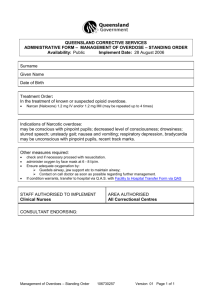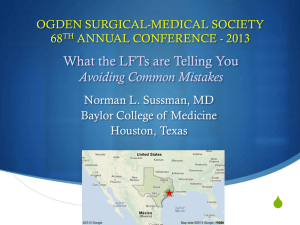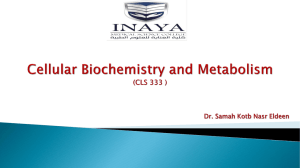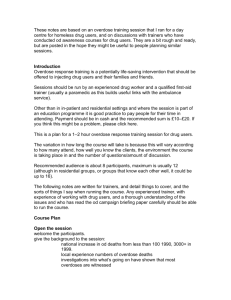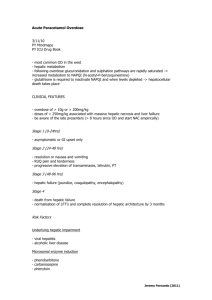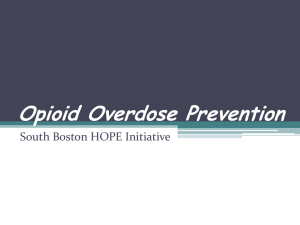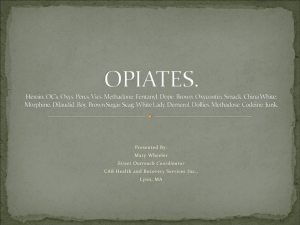Mathematical Modeling of Liver Injury and Dysfunction
advertisement
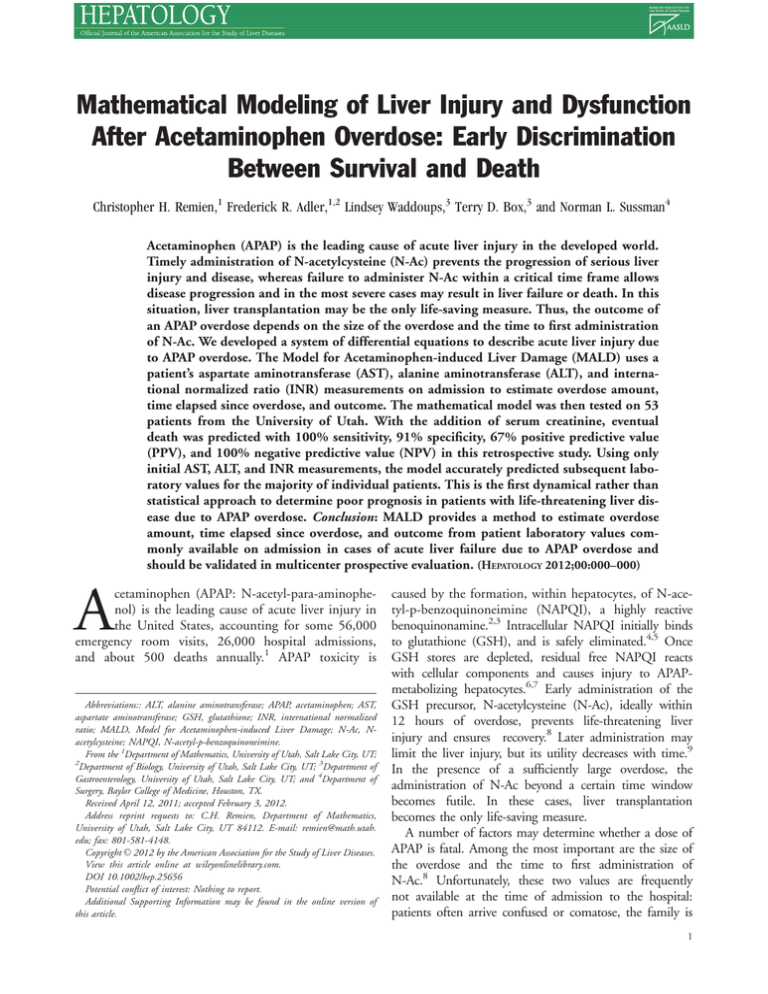
Mathematical Modeling of Liver Injury and Dysfunction After Acetaminophen Overdose: Early Discrimination Between Survival and Death Christopher H. Remien,1 Frederick R. Adler,1,2 Lindsey Waddoups,3 Terry D. Box,3 and Norman L. Sussman4 Acetaminophen (APAP) is the leading cause of acute liver injury in the developed world. Timely administration of N-acetylcysteine (N-Ac) prevents the progression of serious liver injury and disease, whereas failure to administer N-Ac within a critical time frame allows disease progression and in the most severe cases may result in liver failure or death. In this situation, liver transplantation may be the only life-saving measure. Thus, the outcome of an APAP overdose depends on the size of the overdose and the time to first administration of N-Ac. We developed a system of differential equations to describe acute liver injury due to APAP overdose. The Model for Acetaminophen-induced Liver Damage (MALD) uses a patient’s aspartate aminotransferase (AST), alanine aminotransferase (ALT), and international normalized ratio (INR) measurements on admission to estimate overdose amount, time elapsed since overdose, and outcome. The mathematical model was then tested on 53 patients from the University of Utah. With the addition of serum creatinine, eventual death was predicted with 100% sensitivity, 91% specificity, 67% positive predictive value (PPV), and 100% negative predictive value (NPV) in this retrospective study. Using only initial AST, ALT, and INR measurements, the model accurately predicted subsequent laboratory values for the majority of individual patients. This is the first dynamical rather than statistical approach to determine poor prognosis in patients with life-threatening liver disease due to APAP overdose. Conclusion: MALD provides a method to estimate overdose amount, time elapsed since overdose, and outcome from patient laboratory values commonly available on admission in cases of acute liver failure due to APAP overdose and should be validated in multicenter prospective evaluation. (HEPATOLOGY 2012;00:000–000) A cetaminophen (APAP: N-acetyl-para-aminophenol) is the leading cause of acute liver injury in the United States, accounting for some 56,000 emergency room visits, 26,000 hospital admissions, and about 500 deaths annually.1 APAP toxicity is Abbreviations:: ALT, alanine aminotransferase; APAP, acetaminophen; AST, aspartate aminotransferase; GSH, glutathione; INR, international normalized ratio; MALD, Model for Acetaminophen-induced Liver Damage; N-Ac, Nacetylcysteine; NAPQI, N-acetyl-p-benzoquinoneimine. From the 1Department of Mathematics, University of Utah, Salt Lake City, UT; 2 Department of Biology, University of Utah, Salt Lake City, UT; 3Department of Gastroenterology, University of Utah, Salt Lake City, UT; and 4Department of Surgery, Baylor College of Medicine, Houston, TX. Received April 12, 2011; accepted February 3, 2012. Address reprint requests to: C.H. Remien, Department of Mathematics, University of Utah, Salt Lake City, UT 84112. E-mail: remien@math.utah. edu; fax: 801-581-4148. C 2012 by the American Association for the Study of Liver Diseases. Copyright V View this article online at wileyonlinelibrary.com. DOI 10.1002/hep.25656 Potential conflict of interest: Nothing to report. Additional Supporting Information may be found in the online version of this article. caused by the formation, within hepatocytes, of N-acetyl-p-benzoquinoneimine (NAPQI), a highly reactive benoquinonamine.2,3 Intracellular NAPQI initially binds to glutathione (GSH), and is safely eliminated.4,5 Once GSH stores are depleted, residual free NAPQI reacts with cellular components and causes injury to APAPmetabolizing hepatocytes.6,7 Early administration of the GSH precursor, N-acetylcysteine (N-Ac), ideally within 12 hours of overdose, prevents life-threatening liver injury and ensures recovery.8 Later administration may limit the liver injury, but its utility decreases with time.9 In the presence of a sufficiently large overdose, the administration of N-Ac beyond a certain time window becomes futile. In these cases, liver transplantation becomes the only life-saving measure. A number of factors may determine whether a dose of APAP is fatal. Among the most important are the size of the overdose and the time to first administration of N-Ac.8 Unfortunately, these two values are frequently not available at the time of admission to the hospital: patients often arrive confused or comatose, the family is 1 2 REMIEN ET AL. HEPATOLOGY, Month 2012 Fig. 1. A schematic diagram representing the dynamics of the mathematical model. A fraction of APAP is oxidized to NAPQI, bound to GSH, and safely eliminated. As GSH stores are depleted, NAPQI damages hepatocytes, releasing AST and ALT into the blood. Meanwhile, functional hepatocytes regenerate and produce essential clotting factors. Red represents the intracellular variables, yellow represents healthy and damaged hepatocytes, and blue represents markers of liver damage. usually unaware of the timing or the dose of drug taken, and concomitant use of other medications or drugs often obscures the clinical picture. We therefore sought a method for rapidly determining the time of overdose, extent of injury, and likelihood of spontaneous survival using laboratory data available at the time of admission. Our method is based on a mathematical model that describes typical hepatic injury progression, dependent only on overdose amount. Fitting patient laboratory values to our mathematical model allows for the estimation of overdose amount and timing, as well as a prediction of outcome. We tested the mathematical model on 53 patients from the University of Utah. Materials and Methods Model Background. Our mathematical model, the Model of Acetaminophen-induced Liver Damage (MALD), is based on a reproducible pattern of APAPinduced liver injury. The enzymes aspartate aminotransferase (AST) and alanine aminotransferase (ALT) are released by injured hepatocytes.10,11 These enzymes peak at about 36 hours from initial injury and have distinct injury and clearance curves. AST concentration in blood is initially approximately double that of ALT, with a clearance rate of about 50% every 24 hours. ALT peaks at about the same time as AST, but with a slower elimination rate of about 33% every 24 hours.12 These measures of damage are complemented by a measure of liver function, prothrombin time/ international normalized ratio (INR). Decreased production of essential clotting factors manifests as reduced clotting and increased INR, again with characteristic rates of increase and decay.13 The values of AST, ALT, and INR at the time of admission thus encode the course of disease progression over time and can be used, with a suitable mathematical model, to estimate initial dose and time of overdose. Model Description. We developed a system of nonlinear ordinary differential equations to describe the temporal dynamics of APAP-induced acute liver failure (ALF) based on known mechanisms of APAP metabolism (Supporting Information). The equations describe NAPQI production from APAP metabolism, glutathione conjugation, hepatocyte death by NAPQI, release and clearance of AST and ALT in the blood, hepatocyte regeneration, and clotting factor production (Fig. 1). The variables and parameters can be divided into those describing hepatocyte, APAP, glutathione, INR, and AST/ALT dynamics. Functional hepatocytes (H) become damaged hepatocytes (Z) and regenerate with the following parameters: • The number of hepatocytes in a healthy liver is Hmax ¼ 1.6*1011 cells.12,14 • Damaged hepatocytes lyse with rate dz ¼ 5/day. • Functional hepatocytes regenerate with rate r ¼ 1/day.15 • Functional hepatocytes become damaged with rate g ¼ 5.12*1013 cell/mol/day. • The fraction of liver required for survival is l ¼ 0.3.16 Serum APAP (A) is a surrogate for liver APAP, which is converted to NAPQI (N) with the following parameters: HEPATOLOGY, Vol. 000, No. 000, 2012 • APAP is cleared by hepatocytes with rate a ¼ 6.3/day.17 • APAP is cleared unconjugated with rate da ¼ 0.33/day.2,3 • The fraction of APAP that is oxidized to NAPQI is p ¼ 0.05.2,3 • The conversion factor from grams of APAP to mol of NAPQI is q ¼ 0.0067 mol/g. GSH (G) is associated with the following parameters: 18 • GSH binds to NAPQI with rate c ¼ 1.6*10 18 cell/mol/day. 19,20,21 • GSH decays with rate dg ¼ 2/day. 14 • GSH is produced with rate j ¼ 1.375*10 mol/cell/day. INR (I) is related to the clotting factor concentration as a fraction of normal (F) and is associated with the following parameters: • Clotting factor VII is cleared with rate bf ¼ 5/day.22 • The minimum clotting factor concentration is Fmin ¼ 0.75. Serum AST concentration (S) and serum ALT concentration (L) increase and decay with the following parameters: 12 • AST is cleared with rate ds ¼ 0.92/day. 12 • ALT is cleared with rate dl ¼ 0.35/day. • The total amount of AST in a healthy liver is bs ¼ 200,000 IU. • The total amount of ALT in a healthy liver is bl ¼ 84,800 IU. • The amount of blood in a human body is y ¼ 5 L. • The minimum AST level is Smin ¼ 12 IU/L. • The minimum ALT level is Lmin ¼ 9 IU/L. Six parameters were adjusted to match properties of the data, independent of patient survival information. The amounts of AST and ALT in the liver, bs and bl, respectively, were scaled to the maximum observed AST and ALT values, and the minimum AST and ALT levels, Smin and Lmin, respectively, were scaled to the minimum observed AST and ALT values. The minimum clotting factor concentration Fmin was scaled to the maximum observed INR value. The damaged hepatocyte lysis rate dz was adjusted to the timing of peak AST and ALT values. REMIEN ET AL. 3 Two parameters were scaled to the dose of APAP required for hepatotoxicity and death. The glutathione production rate, j, was scaled to the dosage at which glutathione reserves are depleted. The minimum dosage predicted to lead to hepatotoxicity varies, but typically ranges from 7.5 to 10 g for an adult.8,23 We chose a slightly lower value of 6.0 g for the dosage at which glutathione reserves are depleted. The rate at which hepatocytes become damaged by NAPQI, g, is a scaling factor that was chosen so that a 20 g overdose is equivalent to 70% hepatic necrosis and predicted death. Patients. Between January 1, 2006, and December 31, 2009, all hospital discharges from the University of Utah were queried for the diagnosis of severe, acute APAP toxicity. Charts were excluded if they included acute hepatitis A or B, autoimmune hepatitis, Wilson Disease, or multisystem failure. Laboratory data and admission and discharge notes were further reviewed to identify cases in which acute liver disease was due to APAP overdose only. Charts that had overdose with additional medications were not included in this analysis. Demographics, N-Ac administration, and medical outcome information were collected. Laboratory results of AST, ALT, INR, bilirubin, and creatinine were also collected. Charts without at least one measure of AST, ALT, and INR were excluded from the study. In total, 53 patients were included. The patient population was diverse, with varying alcohol use, body mass index, and ingestion type, including suicide attempts, single accidental overdoses, and multiple day chronic overdoses. Ethics Statement. Patient consent was not obtained because data were retrospective, were based on standard care, and were analyzed anonymously. The protocol was approved by the Institutional Review Board (IRB) of the University of Utah in accordance with the Declaration of Helsinki. Serum Creatinine. Serum creatinine was added as an additional criterion separate from the model because it is a marker of kidney damage and our dynamic model does not describe kidney damage. Because kidney function is ultimately important in survival in APAP overdose, patients with serum creatinine greater than 3.4 mg/dL were predicted to die.24 Fitting the Model to Individual Patients. Upon admission, before administration of N-Ac, a patient’s AST, ALT, and INR values in the mathematical model are a function of two parameters, APAP overdose amount, A0, and time since overdose, s. These two parameters were estimated using weighted least-squares and values of AST, ALT, and INR on admission. The weights were determined by posttreatment model fits (see Supporting Information for more details). To test 4 REMIEN ET AL. HEPATOLOGY, Month 2012 Fig. 2. MALD derived estimates of time since overdose and overdose amount for 53 patients with known APAP overdose. Red squares indicate eventual death, green circles recovery, and orange triangles transplant. Small white dots indicate INR > 6.5 and small black dots indicate serum creatinine > 3.4 mg/dL on admission. The gray line indicates overdose amounts and times since overdose for which 70% hepatic necrosis is predicted. Patients to the right and above the gray line are predicted to die. the sensitivity of predicted outcomes to changes in parameters, we increased and decreased each parameter by 50% of its original value and fit individuals to the model, keeping track of the predicted outcome for each patient. Results We tested the model on 53 patients from the University of Utah. The time since overdose and overdose amount were estimated for each patient using initial measurements of AST, ALT, and INR on admission (Fig. 2). Based on the extent of estimated liver injury, the model predicts death for patients who took over 20 g of APAP without N-Ac administration within the first 24 hours. Excluding patients who were transplanted, death versus recovery was predicted with 75% sensitivity and 95% specificity (Table 1). With the addition of initial serum creatinine exceeding 3.4 mg/dL, sensitivity increased to 100%. For this dataset the subset of the King’s College Criteria (KCC) to which we had access (INR > 6.5 and creatinine > 3.4 mg/dL) had 13% sensitivity and 100% specificity. Only one patient had both INR > 6.5 and creatinine > 3.4 on admission. Thinking of the KCC as either INR > 6.5 or creatinine > 3.4 mg/dL increased sensitivity to 88%. We did not have access to patient encephalopathy or arterial pH. Using only data available on admission, the model results fit the posttreatment time-series of the markers of liver damage for the majority of individual patients (Supporting Information Table 2). The results from four representative patients are shown in Fig. 3. Patients 5 and 8 were predicted to have had overdoses that were very close to the lethal threshold, whereas patient 49 was predicted to have exceeded the lethal threshold. Patient 16 was predicted to have had a smaller overdose. The confidence region for some patients who recovered (e.g., patient 16) includes regions with high overdose amount and very early N-Ac administration, as well as regions with low overdose amount and late N-Ac administration. In both cases AST, ALT, and INR are low. Model predictions of outcome were robust to 50% increase or decrease in parameter values (Supporting Information Table 3). The most sensitive model parameters were the fraction of liver required for survival, l, and the amount of AST in the liver, bs. Increasing l to 0.45 caused more patients who eventually recovered to be predicted to die, and resulted in 100% sensitivity and 77% specificity, whereas decreasing l to 0.15 resulted in 88% sensitivity and 93% specificity. Increasing bs by 50% resulted in 100% sensitivity and 79% specificity, whereas decreasing bs by 50% resulted in 88% sensitivity and 88% specificity. Some parameters such as p, the fraction of APAP oxidized to NAPQI, have a large effect on predicted dose of APAP, but no effect on predicted outcome. If p is 0.025, an overdose amount of 40 g is required for 70% hepatic necrosis and predicted death, whereas if p is 0.075, an overdose amount of 13.3 g is required for Table 1. Sensitivity, Specificity, PPV, and NPV for a Subset of King’s College Criteria (INR > 6.5 and Creatinine > 3.4 mg/dL), Either INR > 6.5 or Creatinine > 3.4 mg/dL, and the Current Study Both With and Without Creatinine as an Independent Marker Model INR > 6.5 and creatinine > 3.4 mg/dL INR > 6.5 or creatinine > 3.4 mg/dL MALD (no creatinine) MALD (with creatinine) Sensitivity 0.13 0.88 0.75 1 (1/8, (7/8, (6/8, (8/8, 0-0.53) 0.47-1) 0.35-0.97) 0.63-1) Specificity 1 0.95 0.95 0.91 (43/43, (41/43, (41/43, (39/43, 0.92-1) 0.84-0.99) 0.84-0.99) 0.78-0.97) Absolute numbers and 95% Clopper-Pearson confidence interval are given in parentheses. PPV 1 0.78 0.75 0.67 (1/1, 0-1) (7/9, 0.4-0.97) (6/8, 0.35-0.97) (8/12, 0.35-0.90) NPV 0.86 0.98 0.95 1 (43/50, (41/42, (41/43, (39/39, 0.73-0.94) 0.87-1) 0.84-0.99) 0.91-1) HEPATOLOGY, Vol. 000, No. 000, 2012 REMIEN ET AL. 5 Fig. 3. Markers of liver damage (small black open circles) and model predictions (red dashed line) based on least squares fits of initial AST, ALT, and INR (large black filled circle) to modeled AST, ALT, and INR (large red filled circle) for four representative patients. Time t ¼ 0 indicates the time of admission to hospital. The estimated overdose amount and time since overdose for each patient is given by the orange dot in the lower right panel. Refer to the Supporting Information for more details. 70% hepatic necrosis and predicted death. Estimates of overdose amount scale with lethal dose so that estimates of outcome remain the same despite large changes in estimated overdose amount. Discussion APAP, alone or in combination, accounts for about 50% of cases of ALF in the USA.25 Survival largely depends on two parameters: the size of the initial dose and time elapsed prior to the administration of N-Ac. Very early administration (up to 12 hours after overdose) of N-Ac results in almost 100% survival.8 Some models of APAP toxicity rely on the time between ingestion and hospital admission to determine the need for treatment17 or as a measure of exposure.26 These are risky approaches because the timing of the overdose provided by the patient is frequently unobtainable or unreliable. Moreover, patients who arrive at the hospital 24 hours or more postingestion may have plasma APAP levels below the detection limit. The KCC24 provides a well-validated method for predicting death without transplantation in APAPinduced ALF,27 although they have been criticized for low sensitivity28 and low negative predictive value (NPV).29 KCC used an initial dataset of 310 patients 6 REMIEN ET AL. to identify statistically significant prognostic indicators to distinguish survivors and nonsurvivors and used a validation set of 121 patients to identify cutoff values associated with survival rates less than 20% for the statistically significant prognostic indicators, with no physiologically defined model of mortality. Many modifications of the KCC have been suggested,30–35 perhaps most importantly the addition of arterial lactate.36 Arterial lactate has consistently been shown to be associated with survival, although its prognostic value has been questioned.37 In contrast to other modifications of the KCC, MALD is novel because we build upon the KCC by utilizing an understanding of the dynamics of hepatocyte damage following APAP overdose in the form of a dynamic mathematical model. Hepatic necrosis is directly related to the extent of covalent binding of NAPQI to intracellular components,2,4,6,7 which causes hepatocyte lysis and release of AST and ALT into the blood. This produces a characteristic time course of injury with an early rise and predictable decay of AST, ALT, and INR. We have developed a system of differential equations based on the principles of APAPinduced liver damage. All parameters in MALD were estimated from the literature, except six that were adjusted to match general properties of AST and ALT dynamics, and two that were scaled to the dosages thought to cause hepatotoxicity and death. Survival information from University of Utah patients was not used in model development or parameterization. The equations describe how AST, ALT, and INR levels change over time as a function of overdose amount. Because these curves over time are only a function of initial overdose amount, AST, ALT, and INR levels in the model only depend on initial overdose amount and time since overdose. Our method works by fitting measured AST, ALT, and INR values to the curves described by our differential equations to estimate overdose timing and amount (Fig. 4). An outcome of death is predicted when the estimate of overdose amount is sufficiently high and the estimate of timing predicts N-Ac to be ineffectual, or when serum creatinine measurements are sufficiently high. If the outcome is predicted to be poor, liver transplantation may be the only life-saving treatment. Previous studies have not found absolute aminotransferase levels to be significant predictors of outcome in cases of APAP-induced ALF.24 This is not surprising because aminotransferase levels will be low, even with a high dose, both early and late in the course of the injury based on known mechanisms of liver damage following APAP overdose. Similarly, high HEPATOLOGY, Month 2012 Fig. 4. A schematic description of how MALD can be used to estimate overdose amount, timing, and outcome. Patients’ AST, ALT, and INR are fit to a family of curves described by MALD to estimate overdose amount, timing, and outcome. If outcome is predicted to be poor, liver transplantation may be necessary. aminotransferase levels may be measured near peak liver damage, even in cases of nonlethal overdose. In conjunction with INR and a suitable mathematical model describing these mechanisms, however, aminotransferase levels do contain sufficient information to estimate the timing and amount of overdose. Our model cannot distinguish patients with high overdose amounts and early administration of N-Ac from patients with low overdose amounts and delayed treatment because in both cases AST, ALT, and INR levels are low. However, this ambiguity affects only patients who are predicted to recover. Some patients with unique characteristics, such as those with significant muscle damage, may not fit the model. Muscle damage increases the level of AST, which may lead to poor estimation of liver damage. Because ALT and INR values are not affected by muscle damage, this effect may be minimal. Further studies are warranted to determine whether more refinements are needed for special patient groups. Our treatment of all patients as having the same parameter values is unrealistic. Well-known covariates of disease severity such as age,38 chronic alcohol use,39,40 starvation or malnutrition,41 and interactions with other drugs42,43,44 may affect the parameter values of an individual. In some cases these differences will not affect the accuracy of predictions of outcome. Model predictions derive from the amount of unconjugated NAPQI that results from a given dose, but that amount may depend on patient characteristics. HEPATOLOGY, Vol. 000, No. 000, 2012 For example, alcoholics may make excessive NAPQI because of elevated p-450 levels, or individuals may have decreased levels of GSH because of starvation, competition from other drugs, or genetic variation. These differences might make the model estimates of initial dose seem overly high, but the outcome could still be accurately predicted because these patients have more unconjugated NAPQI than is typical for the overdose amount. James et al.45 show that APAP protein adduct levels may be used as specific biomarkers of APAP toxicity. If measurements were routinely available, adducts could easily be added to our model, and might provide additional predictive value. However, the correlation of protein adducts with AST and their similar kinetics lead us to predict this effect would be small, although their more direct relationship to liver damage might reduce noise and make them a superior predictor. Gregory et al.46 found that individuals with overdose amounts greater than 10 g did not have significantly different mortality than those reporting smaller overdoses in patients with eventual hepatic encephalopathy. The authors suggest that this may be due to inaccurate reporting of dosing information by patients with eventual hepatic encephalopathy, or from a plateau effect in APAP overdose amount, such that above a threshold the effect of APAP overdose ceases to be additive. A plateau is built into our model, but at 20 g rather than 10 g. In our model, without treatment, any overdose above 20 g will result in severe hepatic injury, maximal AST, ALT, and INR levels, and poor outcome. Our patient set is quite different because Gregory et al. required eventual hepatic encephalopathy for inclusion, a parameter unknown on admission and associated with poor prognosis.47 Methods to determine whether to use dangerous and costly interventions, such as transplantation, will ideally be based on clinical data that are readily available at the time of admission. Using only initial measurements of AST, ALT, and INR, we were able to predict the hepatic injury progression and extent of liver damage following APAP overdose. Unlike statistical models to predict outcome, which must build on survivorship data, our mechanistic approach is based on the independently testable assumption that 70% hepatic necrosis leads to death. Our dynamic model yields a prediction of outcome by estimating the time since overdose and overdose amount from commonly obtained laboratory data on admission. With the inclusion of creatinine, we were able, in this retrospective analysis, to predict survival versus death with 91% specificity, 100% sensitivity, 67% PPV, and 100% REMIEN ET AL. 7 NPV. Our initial analysis suggests that MALD compares favorably to statistical methods, and should be validated in multicenter retrospective and prospective evaluation. Acknowledgment: We thank Victor Ankoma-Sey and two anonymous reviewers for critical reviews that greatly improved the article. References 1. Nourjah P, Ahmad SR, Karwoski C, Willy M. Estimates of acetaminophen (Paracetamol)-associated overdoses in the United States. Pharmacoepidemiol Drug Saf 2006;15:398-405. 2. Mitchell JR, Jollow DJ, Potter WZ, Davis DC, Gillette JR, Brodie BB. Acetaminophen-induced hepatic necrosis. I. Role of drug metabolism. J Pharmacol Exp Ther 1973;187:185-194. 3. Bond GR. Acetaminophen protein adducts: a review. Clin Toxicol 2009;47:2-7. 4. Mitchell JR, Jollow DJ, Potter WZ, Gillette JR, Brodie BB. Acetaminophen-induced hepatic necrosis. IV. Protective role of glutathione. J Pharmacol Exp Ther 1973;187:211-217. 5. Mitchell JR, Thorgeirsson SS, Potter WZ, Jollow DJ, Keiser H. Acetaminophen-induced hepatic injury: protective role of glutathione in man and rationale for therapy. Clin Parmacol Ther 1974;16:676-684. 6. Potter WZ, Davis DC, Mitchell JR, Jollow DJ, Gillette JR, Brodie BB. Acetaminophen-induced hepatic necrosis. III. Cytochrome p-450 mediated covalent binding in vitro. J Pharmacol Exp Ther 1973;187:203-210. 7. Jollow DJ, Mitchell JR, Potter WZ, Davis DC, Gillette JR, Brodie BB. Acetaminophen-induced hepatic necrosis II. Role of covalent binding in vivo. J Pharmacol Exp Ther 1973;187:195-202. 8. Schmidt LE, Dalhoff K, Poulsen HE. Acute versus chronic alcohol consumption in acetaminophen-induced hepatotoxicity. HEPATOLOGY 2002; 35:876-882. 9. Smilkstein MJ, Knapp GL, Kulig KW, Rumack BH. Efficacy of oral N-acetylcystein in the treatment of acetaminophen overdose: analysis of the National Multicenter Study (1975 to 1985). N Engl J Med 1988; 319:1557-1562. 10. Singer AJ, Carracio TR, Mofenson HC. The temporal profile of increased transaminase levels in patients with acetaminophen-induced liver dysfunction. Ann Emerg Med 1995;25:49-53. 11. Slattery JT, Wilson JM, Kalhorn TF, Nelson SD. Dose-dependent pharmacokinetics of acetaminophen: evidence of glutathione depletion in humans. Clin Pharmacol Ther 1987;41:413-418. 12. Price CP, Alberti KGMM. Biochemical assessment of liver function. In: Wright R, Alberti KGMM, Karran S, Millward-Sadler GH, eds. Liver and Biliary Disease: Pathophysiology, Diagnosis, Management. London: WB Saunders; 1979:381-416. 13. Harrison PM, O’Grady JG, Keays RT, Alexander GJ, Williams R. Serial prothrombin time as prognostic indicator in paracetamol induced fulminant hepatic failure. Br Med J 1990;301:964-966. 14. Sohlenius-Sternbeck AK. Determination of the hepatocellularity number for human, dog, rabbit, rat and mouse livers from protein concentration measurements. Toxicol In Vitro 2006;20:1582-1586. 15. Furchtgott LA, Chow CC, Periwal V. A model of liver regeneration. Biophys J 2009;96:3926-3935. 16. Donaldson BW, Gopinath R, Wanless IR, Phillips MJ, Cameron R, Roberts EA, et al. The role of transjugular liver biopsy in fulminant liver failure: relation to other prognostic indicators. HEPATOLOGY 1993; 18:1370-1376. 17. Rumack BH, Matthew H. Acetaminophen poisoning and toxicity. Pediatrics 1975;55:871-876. 18. Miner DJ, Kissinger PT. Evidence for the involvement of n-acetyl-pbenzoquinone imine in acetaminophen metabolism. Biochem Pharmacol 1979;28:3285-3290. 8 REMIEN ET AL. 19. Ookhtens M, Hobdy K, Corvasce MC, Aw TY, Kaplowitz N. Sinusoidal efflux of glutathione in the perfused rat liver. J Clin Invest 1985; 75:258-265. 20. Lauterburg BH, Adams JD, Mitchell JR. Hepatic glutathione homeostasis in the rat: efflux accounts for glutathione turnover. HEPATOLOGY 1984;4:586-590. 21. Aw TY, Ookhtens M, Clement R, Kaplowitz N. Kinetics of glutathione efflux from isolated rat hepatocytes. Am J Physiol Gast Liver 1986;250: G236-G243. 22. Pehlivanov B, Milchev N, Kroumov G. Factor VII deficiency and its treatment in delivery with recombinant factor VII. Eur J Obst Gynecol Reprod Biol 2004;116:237-238. 23. Chun LJ, Tong MJ, Busuttil RW, Hiatt JR. Acetaminophen hepatotoxicity and acute liver failure. J Clin Gastroenterol 2009;43:342-349. 24. O’Grady JG, Alexander GJ, Hayllar KM, Williams R. Early indicators of prognosis in fulminant hepatic failure. Gastroenterology 1989;97: 439-445. 25. Lee WM, Squires RH, Nyberg SL, Doo E, Hoofnagle JH. Acute liver failure: summary of a workshop. HEPATOLOGY 2008;47:1401-1415. 26. Sivilotti MLA, Good AM, Yarema MC, Juurlink DN, Johnson DW. A new predictor of toxicity following acetaminophen overdose based on pretreatment exposure. Clin Toxicol 2005;43:229-234. 27. Craig DG, Ford AC, Hayes PC, Simpson KJ. Systematic review: prognostic tests of paracetamol-induced acute liver failure. Aliment Pharmacol Ther 2010;31:1064-1976. 28. Bailey B, Amre DK, Gaudreault P. Fulminant hepatic failure secondary to acetaminophen poisoning: a systematic review and meta-analysis of prognostic criteria determining the need for liver transplantation. Crit Care Med 2003;31:299-305. 29. Renner EL. How to decide when to list a patient with acute liver failure for liver transplantation? Clichy or King’s College Criteria, or something else? J Hepatol 2007;46:554-557. 30. Schmidt LE, Dalhoff K. Alpha-fetoprotein is a predictor of outcome in acetaminophen-induced liver injury. HEPATOLOGY 2005;41:26-31. 31. Mitchell I, Bihari D, Chang R, Wendon J, Williams R. Earlier identification of patients at risk from acetaminophen-induced acute liver failure. Crit Care Med 1998;26:279-284. 32. Bernal W, Auzinger G, Sizer E, Wendon J. Early prediction of outcome of acute liver failure using bedside measurement of interleukin-6. HEPATOLOGY 2007;46(Suppl 1):617A. 33. Zaman MB, Hoti E, Qasim A, Maguire D, McCormick PA, Hegarty JE, et al. MELD score as a prognostic model for listing acute liver HEPATOLOGY, Month 2012 34. 35. 36. 37. 38. 39. 40. 41. 42. 43. 44. 45. 46. 47. failure patients for liver transplantation. Transplant Proc 2006;38: 2097-2098. Bechmann LP, Jochum C, Kocabayoglu P, Sowa JP, Kassalik M, Gieseler RK, et al. Cytokeratin 18-based modification of the MELD score improves prediction of spontaneous survival after acute liver injury. J Hepatol 2010;53:639-647. Bernal W, Wendon J. More on serum phosphate and prognosis of acute liver failure. HEPATOLOGY 2003;38:533-534. Bernal W, Donaldson N, Wyncoll D, Wendon J. Blood lactate as an early predictor of outcome in paracetamol-induced acute liver failure: a cohort study. Lancet 2002;359:558-563. Schmidt LE, Larsen FS. Is lactate concentration of major value in determining the prognosis in patients with acute liver failure? Hardly. J Hepatol 2010;53:211-212. Rumack BH. Acetaminophen overdose in young children. Am J Dis Child 1984;138:428-433. McClain CJ, Kromhout JP, Peterson FJ, Holtzman JL. Potentiation of acetaminophen hepatotoxicity by alcohol. JAMA 1980;244:251-253. Lesser PB, Vietti MM, Clark WD. Lethal enhancement of therapeutic doses of acetaminophen by alcohol. Dig Dis Sci 1986;3:103-105. Bonkovsky HL, Kane RE, Jones DP, Galinsky RE, Banner B. Acute hepatic and renal toxicity from low doses of acetaminophen in the absence of alcohol abuse of malnutrition: evidence for increased susceptibility to drug toxicity due to cardiopulmonary and renal insufficiency. HEPATOLOGY 1994;19:1141-1148. McClements BM, Hyland M, Callender ME, Blair TL. Management of paracetamol poisoning complicated by enzyme induction due to alcohol or drugs. Lancet 1990;335:1526. Pirotte JH. Apparent potentiation of hepatotoxicity from small doses of acetaminophen by phenobarbital. Ann Intern Med 1984;101:403. Crippin JS. Acetaminophen hepatotoxicity: potentiation by isoniazid. Am J Gastroenterol 1993;88:590-592. James LP, Letzig L, Simpson PM, Capparelli E, Roberts DW, Hinson JA, et al. Pharmacokinetics of acetaminophen protein adducts in adults with acetaminophen overdose and acute liver failure. Drug Metab Dispos 2009;37:1-6. Gregory B, Larson AM, Reisch J, Lee WM. Acetaminophen dose does not predict outcome in acetaminophen-induced acute liver failure. J Invest Med 2010;58:707-710. Larson AM, Polson J, Fontana RJ, Davern TJ, Lalani E, Hynan LS, et al. Acetaminophen-induced acute liver failure: Results of a United States multicenter, prospective study. HEPATOLOGY 2005;42:1364-1372.
